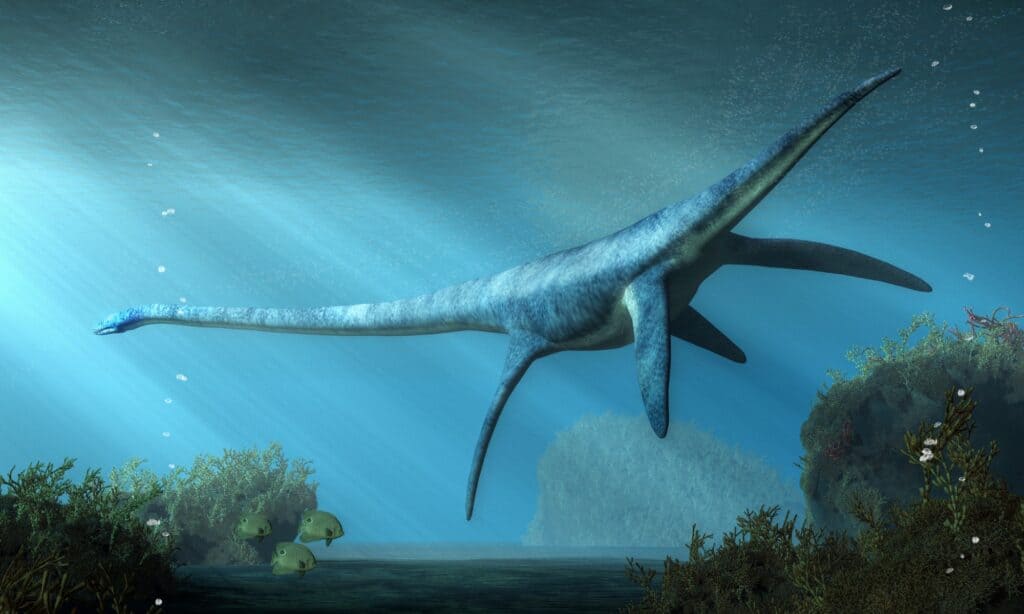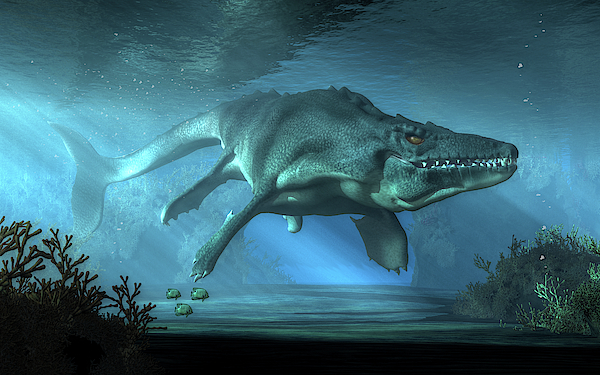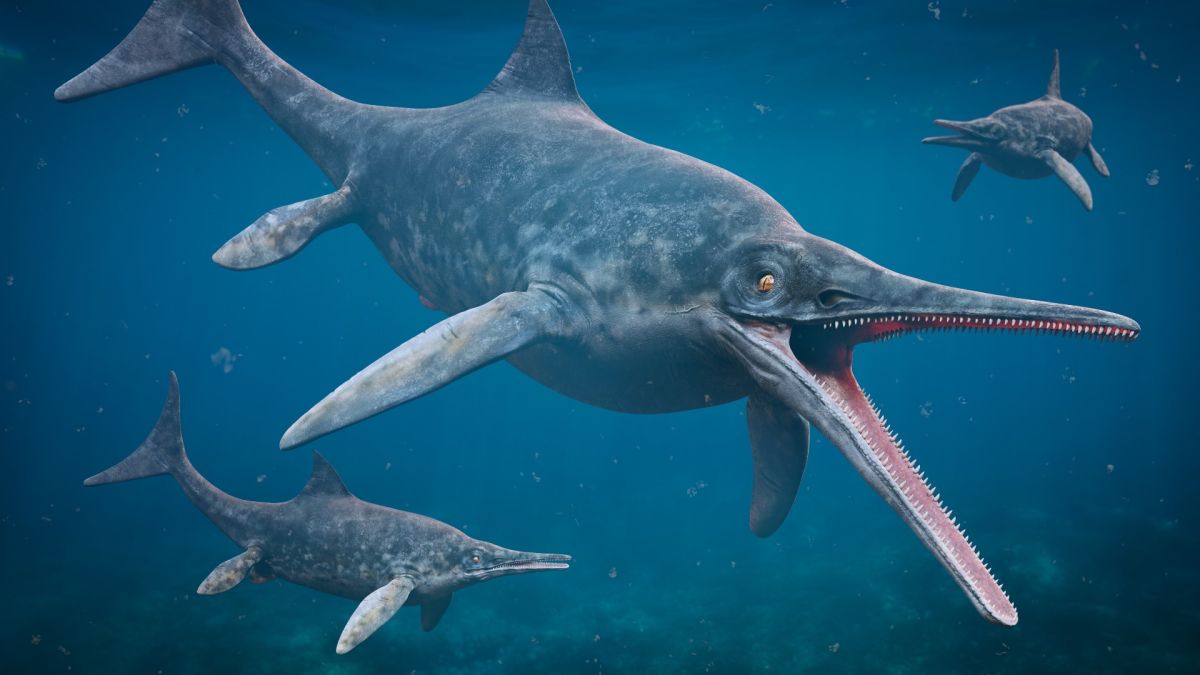During the age of dinosaurs, not all the incredible creatures were land-dwelling. Some of the most fascinating and awe-inspiring creatures were the prehistoric swimming and flying reptiles. These ancient beings ruled the seas and skies, showcasing a diverse range of shapes, sizes, and adaptations.
In this article, we will explore the top 10 prehistoric swimming and flying reptiles, from the largest and most fearsome to the lesser-known but equally intriguing species.
You are reading: Discover the Top 10 Prehistoric Swimming and Flying Reptiles
Top 10 Prehistoric Swimming and Flying Reptiles
Quetzalcoatlus
– Scientific Name: Quetzalcoatlus
– Period: Late Cretaceous (Maastrichtian)
– Location: North America
Quetzalcoatlus is a genus of azhdarchid pterosaur, known for being one of the largest flying animals of all time. Its name is derived from the Aztec feathered serpent god, Quetzalcoatl. The two confirmed species of Quetzalcoatlus, along with other azhdarchids, were the largest known flying animals of their time, with giant wingspans and long, stiffened necks.
Unlike the serpent god it was named after, Quetzalcoatlus had no feathers. Its body, including its wings made of skin and fibers of keratin, was covered with hair, as in all pterosaurs. This prehistoric creature is believed to have been warm-blooded and active, similar to dinosaurs.
The exact lifestyle and feeding habits of Quetzalcoatlus are still a subject of debate among scientists. Some believe it was an opportunistic carnivore, feeding on both carrion and live prey, while others suggest it had a lifestyle similar to that of a stork, stalking small prey items like lizards and insects.
Quetzalcoatlus had a long, sharp beak, similar to modern storks, which is often used as evidence for its ground-hunting behavior. Its front and back limbs also support the hypothesis that it may have hunted small animals on the ground, similar to storks or hornbills.
Arambourgiania
– Scientific Name: Arambourgiania
– Period: Late Cretaceous (Maastrichtian stage)
– Location: Jordan, possibly the United States
Arambourgiania is an extinct genus of azhdarchid pterosaur, belonging to the same family as Quetzalcoatlus. It is one of the largest flying animals ever known, with an estimated wingspan of around 10 meters (30 feet) or more. This prehistoric creature lived during the Late Cretaceous period, alongside dinosaurs like Tyrannosaurus rex.
The name “Arambourgiania” was given to this pterosaur in 1989 by Russian paleontologist Lev Nesov, in honor of French paleontologist Camille Arambourg. However, the name “Titanopteryx” was informally used in the West, partially because the new name was assumed by many to be a nomen dubium.
Arambourgiania is known for its unusually long neck, earning it the description of a “flying animal with a giraffe-like neck”. Recent research has suggested that the single known bone of Arambourgiania is actually part of a neck vertebra, not a bone from the hand as previously thought.
Like other azhdarchid pterosaurs, Arambourgiania was likely a skilled hunter, capable of both hunting and scavenging for food. Its large size and unique features make it a fascinating and lesser-known member of the prehistoric flying reptile family.
Liopleurodon
– Scientific Name: Liopleurodon
– Period: Middle to Late Jurassic (Callovian to Kimmeridgian stages)
– Location: Europe
Liopleurodon, meaning “smooth-sided teeth,” was an extinct genus of large, carnivorous marine reptile belonging to the Thalassophonea, a clade of short-necked pliosaurid plesiosaurs. It lived during the Middle to Late Jurassic period, approximately 166 to 155 million years ago, and was the apex predator of the seas that covered Europe during that time.
The genus name Liopleurodon was coined by Henri Émile Sauvage in 1873. Sauvage named three species which he assigned to this genus, each based on a single tooth. One tooth, measuring 7.5 centimeters (3.0 inches) long, was found near Boulogne-sur-Mer, France, in layers dating from the Callovian, and was named Liopleurodon ferox. Another tooth, measuring 7 centimeters (2.8 inches) long with a crown length of 5.5 centimeters (2.2 inches), was named Liopleurodon grossouvrei.
Liopleurodon was a formidable predator, with a skull and jaws that took up one-fifth of its total length, giving it a powerful bite. It is often recognized for its appearance as the villain in the BBC’s “Walking with Dinosaurs” TV series. The exact size of Liopleurodon is still a topic of debate among scientists, with estimates ranging from 5 to 15 meters (16 to 49 feet) in length.
Read more : Discover The Top 5 Most Expensive Types Of Caviar In 2023
This prehistoric marine reptile remains a fascinating and iconic creature of the Jurassic seas, showcasing the diversity and power of the ancient world’s top predators.
Shastasaurus
– Scientific Name: Shastasaurus
– Period: Middle to Late Triassic
– Location: United States, Canada, China
Shastasaurus, meaning “Mount Shasta lizard,” is an extinct genus of ichthyosaur, the largest known marine reptile from the middle to late Triassic period. Specimens of Shastasaurus have been found in various locations, including the United States, Canada, and China. The type species, Shastasaurus pacificus, is known from California, while a second possible species, S. sikanniensis, has been identified in the Pardonet Formation in British Columbia, dating to the middle Norian age (about 210 million years ago).
Shastasaurus had a unique and specialized mouth, with short jaws and a toothless adaptation. This distinguishes it from other ichthyosaurs, which typically had conical teeth for capturing prey. The exact size of Shastasaurus is still a topic of debate among scientists, with estimates ranging from over 7 meters (23 feet) in length and weighing 1.5 metric tons (1.7 short tons) for S. pacificus.
This prehistoric marine reptile’s small head, short snout, and lack of teeth set it apart from its contemporaries, making it a fascinating and distinct member of the ichthyosaur family. Shastasaurus provides valuable insights into the diverse and unique adaptations of ancient marine creatures that once ruled the oceans alongside the dinosaurs.
Dakosaurus
– Scientific Name: Dakosaurus
– Period: Late Jurassic to Early Cretaceous
– Location: Europe, North America, South America
Dakosaurus is an extinct genus of crocodylomorph within the family Metriorhynchidae that lived during the Late Jurassic and Early Cretaceous periods. This prehistoric marine reptile was large, with teeth that were serrated and compressed lateromedially, meaning they were flattened from side to side. Here are some key facts about Dakosaurus:
– Size: Dakosaurus was approximately 4 to 5 meters (13 to 16 feet) long.
– Diet: It was a carnivorous predator, likely feeding on fish and other marine animals.
– Habitat: Dakosaurus inhabited shallow seas in Eurasia, North America, and South America.
– Skull and Teeth: It had a skull similar to that of a carnivorous dinosaur, with large, jagged teeth that allowed for a powerful bite.
– Species: The type species of Dakosaurus is D. maximus, known from the Mörnsheim Formation (Solnhofen limestone, early Tithonian) of Bavaria, Germany. Another species, D. andiniensis, has been identified in South America.
Dakosaurus was a formidable marine predator, showcasing the diversity and adaptations of ancient reptiles that once ruled the oceans. Its large size, powerful bite, and unique tooth structure made it a successful hunter in its prehistoric environment.
Elasmosaurus

– Scientific Name: Elasmosaurus platyurus
– Period: Late Cretaceous (Campanian)
– Location: North America
Elasmosaurus is an extinct genus of plesiosaur that lived in North America during the Campanian stage of the Late Cretaceous period, approximately 80.5 million years ago. Here are some key facts about Elasmosaurus:
– Size: Elasmosaurus was one of the largest plesiosaurs, reaching up to 46 feet in length. However, much of its length was accounted for by its incredibly long and serpentine neck.
– Classification: It belongs to the family Elasmosauridae, a group of long-necked marine reptiles that are part of the order Plesiosauria.
– Diet: Elasmosaurus was a carnivorous predator, feeding on fish and cephalopods.
– Habitat: It inhabited a marine environment, coexisting with many dinosaurs but not being a dinosaur itself.
– Reproduction: Elasmosaurus is believed to have reproduced through live birth.
– First Discovery: The first Elasmosaurus fossil was discovered in 1868.
Elasmosaurus is known for its unique and distinctive long neck, which researchers believe allowed it to quickly reposition and catch prey that would otherwise be able to out-maneuver its larger body mass.
As one of the largest and most fascinating plesiosaurs, Elasmosaurus provides valuable insights into the diversity and adaptations of ancient marine reptiles that once roamed the oceans.
Mosasaurus

– Scientific Name: Mosasaurus
– Period: Late Cretaceous (Campanian and Maastrichtian stages)
– Location: Europe and North America
Mosasaurus is the type genus of the mosasaurs, an extinct group of aquatic squamate reptiles that lived from about 82 to 66 million years ago during the Late Cretaceous period. Here are some key facts about Mosasaurus:
– Size: The largest species of Mosasaurus could grow to over 50 feet long, with a streamlined skull bristling with teeth, a barrel-like trunk for its midsection, and a long, powerful tail. However, the most common forms were no larger than modern porpoises.
– Classification: Mosasaurus was a type of derived mosasaur, or a late-coming member with advanced evolutionary traits.
– Diet: Mosasaurus was a carnivorous predator, feeding on a variety of prey such as seabirds, sharks, large fish, and plesiosaurs.
– Habitat: It inhabited the oceans of the Late Cretaceous period, competing with other marine reptiles for food, including plesiosaurs and ichthyosaurs.
– Respiration: Mosasaurus lived near the surface of the water, breathing air like whales do.
– First Discovery: The name Mosasaurus means “Meuse lizard,” referring to the Meuse River near which the first fossil specimen was discovered.
Early paleontologists initially suspected that Mosasaurus was an ancient crocodile or monitor lizard, but it eventually became clear that it was a different species altogether, unrelated to any modern animal.
Read more : Discover 8 Types Of Horned Animals
As one of the most well-known and fascinating marine reptiles of the Late Cretaceous, Mosasaurus provides valuable insights into the diversity and adaptations of prehistoric aquatic life.
Ichthyosaurus

– Scientific Name: Ichthyosaurus
– Period: Early Jurassic (Hettangian – Pliensbachian), with a possible Late Triassic record
– Location: Europe (Belgium, England, Germany, Switzerland, and Portugal)
Ichthyosaurus is a genus of ichthyosaurs, an extinct group of aquatic reptiles that lived during the Early Jurassic period, approximately 201 to 183 million years ago. Here are some key facts about Ichthyosaurus:
– Size: Ichthyosaurus was about 3 meters (10 feet) long, making it a relatively small ichthyosaur.
– Appearance: It had a streamlined body with no distinct neck, and its head blended smoothly into the body. The limbs were modified into paddle-like appendages used for steering.
– Diet: Ichthyosaurus was a carnivorous predator, feeding on fish and other small marine animals.
– Habitat: It inhabited the oceans of the Early Jurassic period, swimming at high speeds and using its large eyes to discern large shapes, such as those of pliosaurs, at long distances.
– Discovery: The genus Ichthyosaurus is among the best-known ichthyosaur genera, as it is the type genus of the order Ichthyosauria. Many well-preserved specimens have been found in England and Germany, dating back to the Early Jurassic period.
– Mary Anning’s Ichthyosaur: One notable specimen of Ichthyosaurus was discovered by the British paleontologist Mary Anning in the Lower Jurassic rocks of Lyme Regis. This specimen is a partial skeleton of a young ichthyosaur with preserved stomach contents, providing valuable insights into its diet and feeding habits.
Ichthyosaurus is an important genus for understanding the diversity and adaptations of prehistoric marine reptiles, and its well-preserved fossils have provided significant contributions to the field of paleontology.
Pteranodon
– Scientific Name: Pteranodon
– Period: Late Cretaceous (89.8 – 70.6 million years ago)
– Location: North America (present-day Kansas, Nebraska, Wyoming, South Dakota, and Alabama)
Pteranodon is a genus of pterosaur, a type of flying reptile that lived during the Late Cretaceous period, approximately 89.8 to 70.6 million years ago. Here are some key facts about Pteranodon:
– Size: Pteranodon included some of the largest known flying reptiles, with P. longiceps having a wingspan of over 6 meters (20 feet). The wingspan of Pteranodon ranged from 9 to 20 feet (2.7 to 6 meters).
– Appearance: Pteranodon had a long, toothless beak, a large crest on the back of its head, and a wingspan that allowed it to soar over open ocean waters.
– Diet: Pteranodon was a piscivore, meaning it primarily ate fish. It would have used its sharp beak and long jaws to catch and consume its prey.
– Habitat: Pteranodon lived in a marine environment, specifically the Late Cretaceous seas of North America. It is believed to have spent much of its time soaring over open ocean waters, similar to modern-day albatrosses.
– Fossil Record: Pteranodon species are extremely well-represented in the fossil record, with over 1,000 specimens identified. However, less than half of these specimens are complete enough to provide researchers with good anatomical information.
– Not a Dinosaur: Although Pteranodon lived during the same period as dinosaurs, it was not a dinosaur itself. Pteranodon was a type of pterosaur, a group of flying reptiles that were distinct from dinosaurs.
Pteranodon is one of the most well-known and iconic pterosaurs, and its fossils have provided valuable insights into the diversity and adaptations of prehistoric flying reptiles.
Ikrandraco Avatar
– Scientific Name: Ikrandraco avatar
– Period: Lower Cretaceous (Aptian-age, approximately 120 million years ago)
– Location: Northeastern China (Jiufotang Formation) and the Cambridge Greensand of the UK
Ikrandraco avatar is a genus of lonchodraconid pterodactyloid pterosaur, known for its unique skull with a crest on the lower jaw. The name “Ikrandraco” is derived from the ikrans or mountain banshees, the dragon-like flying creatures from the blockbuster film “Avatar”. Here are some key facts about Ikrandraco avatar:
– Size: The size of Ikrandraco avatar is not explicitly mentioned in the available search results.
– Appearance: Ikrandraco avatar had a long, low skull, with the height of the back of the skull at the quadrates being less than 19% of the length of the skull. Its head was similar to the flying creature “ikran” from the movie “Avatar”.
– Diet: Researchers have suggested that Ikrandraco avatar may have had a throat pouch, similar to a pelican, for storing food. It is believed to have foraged for food by hovering over water and scooping up prey near the surface.
– Habitat: Ikrandraco avatar lived during the Lower Cretaceous period, in both the Jiufotang Formation in northeastern China and the Cambridge Greensand of the UK.
– Fossil Record: Two specimens of Ikrandraco avatar have been uncovered from the Jiufotang Formation, including a partial skeleton with the skull and jaws, several neck vertebrae, a partial sternal plate, parts of both wings, and part of a foot (IVPP V18199), as well as a second specimen consisting of a skull, jaws, and the first three neck vertebrae (IVPP 18406).
Ikrandraco avatar is an intriguing pterosaur with a unique skull structure, and its name pays homage to the dragon-like creatures from the movie “Avatar.” Its discovery has provided valuable insights into the diversity and adaptations of prehistoric flying reptiles.
FAQS
1. What is the difference between dinosaurs and pterosaurs?
Dinosaurs are a group of land-dwelling reptiles that first appeared about 251 million years ago, while pterosaurs were flying reptiles that lived during the same time as dinosaurs. Pterosaurs were not dinosaurs but were close cousins of dinosaurs, evolving on a separate branch of the reptile family tree.
2. Did pterosaurs and dinosaurs coexist?
Yes, pterosaurs and dinosaurs lived during the same time, but they were distinct groups of reptiles. Pterosaurs existed from the Late Triassic to the end of the Cretaceous period, which is the same time span as dinosaurs.
3. What did pterosaurs eat?
Pterosaurs were carnivores, and their diet varied depending on their habitat. Some species lived around water and ate fish, while others were more terrestrial and hunted small prey such as lizards, insects, and even baby dinosaurs.
4. How long did pterosaurs exist?
Pterosaurs flourished for more than 150 million years, from the Late Triassic to the end of the Cretaceous period. They evolved into a broad variety of species, with some as large as an F-16 fighter jet and others as small as a paper airplane.
5. What are some examples of pterosaurs?
Some well-known pterosaurs include Pterodactylus, Rhamphorhynchus, Scaphognathus, Quetzalcoatlus, Arambourgiania, and Pteranodon. These pterosaurs varied in size, shape, and diet, reflecting the diversity of this group of flying reptiles.
Source: https://petstutorial.com
Category: Animals










